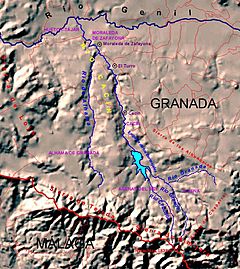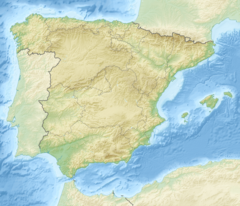Cacín River facts for kids
Quick facts for kids Cacín River |
|
|---|---|

Cacín River canyon (Tajo de los Bermejales)
|
|

Cacin flows north from the Bermejales reservoir (light blue) to the Rio Genil (top)
|
|
| Country | Spain |
| Autonomous community | Andalusia |
| Province | Granada |
| Physical characteristics | |
| Main source | Embalse de los Bermejales 36°59′49″N 3°53′36″W / 36.996925°N 3.893436°W |
| River mouth | 37°12′44″N 4°01′03″W / 37.212090°N 4.017370°W |
| Basin features | |
| River system | Genil |
The Cacín River (called Río Cacín in Spanish) is a river in Andalusia, a region in southern Spain. It gets its water from streams that flow north from the Sierra de Almijara and Sierra de Tejeda mountains. These streams empty into the Granada Basin.
The river starts at the Los Bermejales Reservoir. From there, it flows north until it joins the Genil river. In its upper parts, the Cacín River flows through a very deep gorge. Scientists have found signs that people lived in this gorge a very long time ago, during the Paleolithic period.
Contents
How the River Formed
Long, long ago, about 9 to 5 million years ago, the area where the Cacín River is now was like a giant bowl. Rivers flowed into a big lake in the middle, but no water flowed out. This kind of area is called an endorheic basin.
Later, about 5 million years ago, the western part of this basin started to drain. The ancient Cacín River system formed and flowed north, eventually leaving the basin towards the west. This river carried sediments, like sand and clay, from the nearby mountains.
Even later, the Genil River, which was in the eastern part of the basin, changed its path. It started flowing west and joined the Cacín River system. This made the entire basin open up, allowing water to flow out. Since then, the main process in the area has been erosion, which means the river has been carving out the land.
The River's Path
The Cacín River begins where several streams meet in the Los Bermejales Reservoir. These streams come from the Sierras of Tejeda, Almijara and Alhama Natural Park.
As it flows north, the river goes through a narrow canyon. This canyon is famous and is known as the Tajos de los Bermejales. Here, the river has carved drops that are up to 100 meters (about 330 feet) deep!
The Cacín River helps water the farmlands in the western part of the Vega de Granada region. Finally, it joins the Genil river southwest of a town called Villanueva Mesía.
Tajos de los Bermejales Gorge
The Tajos de los Bermejales gorge is located in the comarca de Alhama area, near the town of Arenas del Rey. It stretches from the Bermejales dam to a place called the Roman bridge. Interestingly, this "Roman" bridge was actually built in the 1940s!
You can explore the gorge on a challenging walking trail. This trail includes exciting parts like hanging bridges, ladders, and ropes to help you get around. The river created this deep gorge by cutting through soft rocks like sandstones, clays, and conglomerates over many years.
Wildlife in the Gorge
The tall canyon walls are home to many different kinds of birds. You might see birds of prey like the common kestrel and Eurasian eagle-owl. There are also colonies of western jackdaw, rock dove, and other birds such as the rock thrush, wheatear, bee-eater, barn swallow, and Eurasian crag martin. If you are lucky, you might even spot the Southeastern Spanish ibex, a type of wild goat, in the gorge.
Ancient Inhabitants
About 5,000 years ago, during the Neolithic period, people lived in the Cacín River canyon. They found shelter under the overhanging rock walls and used the river for food.
You can still see traces of these early settlers on the canyon walls. They built walls to close off natural caves, and some of these walls are still visible today. Back then, the canyon was not as deep as it is now. People used stairways and ladders to reach their homes, which they built high up for protection.
An important clay pot, known as the Olla de Cacín (Cacín Pot), was found in the riverbed. It is now kept in the National Archaeological Museum, Madrid. This pot is a special type of pottery called Cardium pottery. It is the southernmost example of this kind of pottery found in Europe.
See also
 In Spanish: Río Cacín para niños
In Spanish: Río Cacín para niños


